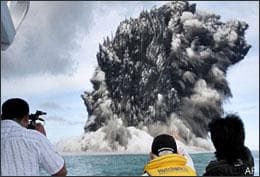Advertisement
Volcanic Planet
Resume
It’s volcano time in Alaska. Mount Redoubt, 100 miles southwest of Anchorage, blowing miles high over the land of grizzly bear and glacier.
And in the South Pacific — off the coast of Tonga — an undersea volcano erupting up through the waves in a spectacular display.
We don’t get to talk with volcanologists often here. Today we will — about the eruptions this week, the deep-Earth plumbing that makes them blow, and the consequences on the ground, the sea, and in the air, of all that power.
This hour, On Point: It's volcano time. We’ll bring in the volcanologists.
You can join the conversation. Have you been following the reports from Redoubt? From north and south and South Pacific? What's your experience of volcanoes? Your question on volcanoes?Guests:
Peter Cervelli joins us from the operations room of the Alaska Volcano Observatory in Anchorage. He's the volcanologist and geophysicist on the job there.
From Girdwood, Alaska, we're joined by Cyrus Read. He's an engineer and geophysicist with the Alaska Volcano Observatory and travelled to the Mt. Redoubt observation hut this week. See images of the current Redoubt activity.
With us from Washington, DC, is Marianne Guffanti, senior geologist with the U.S. Geological Survey. She is the lead scientist for the USGS on the issue of volcanic hazards to aviation and serves as a technical advisor to the Federal Aviation Administration.
And from Pasadena, California, we're joined by Mark Simons, professor of geophysics in the Seismological Laboratory at the California Institute of Technology (Caltech). He studies volcanoes worldwide using satellite imagery to detect bulges in the Earth’s crust as volcanoes become active.
Here's a shot from the Redoubt webcam on Monday, March 23:

And here's an amazing YouTube video of the eruption off the coast of Tonga in the South Pacific last week (more from YouTube here):
And here's a video from the Discovery Channel highlighting their five favorite volcano webcams around the world...
This program aired on March 26, 2009.